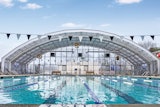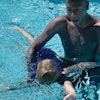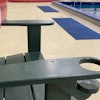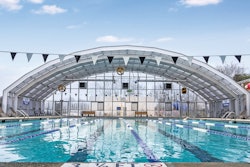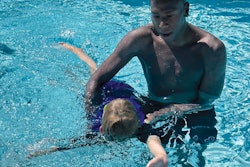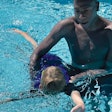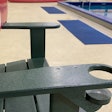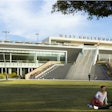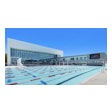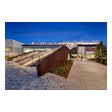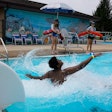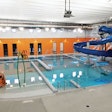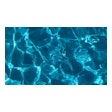Theming of aquatic facilities has trickled down from major water parks to municipal recreation centers and even high schools
Professor Frogstein had fallen into proverbial deep water. As Professor Stein, he was close to discovering the formula for family fun -- something his arch-nemesis, Dr. Unfun, was determined to keep secret from the world. The latter therefore turned his former colleague into a white-coated amphibian scientist, doomed to toil in a swamp laboratory.
That fanciful story is what lies behind the very real Frogstein's Splashatory, a five-level play structure at NRH2O in North Richland Hills, Texas, that includes six water slides, an array of interactive water activities and a giant tipping beaker.
"The swamp is supposed to be where the formula was discovered, and the park sprung up around it," explains Elizabeth Copeland, marketing specialist at NRH2O, which since 1995 has borne the tagline, "The formula for family fun." But while NRH2O established its storyline prior to opening that year, and created a mascot and park graphics to go with it, it didn't carry the theme into its actual water-play equipment until the 2004 summer swim season.
And that pretty well describes the trend in water-play equipment all across the country. Theming of aquatic facilities has been done here and there for a number of years, with the concept trickling down from major water parks to smaller water parks and now to municipal recreation centers and even some high schools. But the wide proliferation of what a scientist, human or otherwise, might call a "unified theory of water-park theming" is a more recent phenomenon. Facility owners are driving the trend, coming to water-play equipment manufacturers with requests for custom designs that integrate different aspects of often-elaborate narratives.
As Pat Won, a senior designer with Columbus, Ohio-based equipment manufacturer Whitewater West Industries Ltd., recounts Professor Frogstein's travails, it's hard not to smile at the level of whimsy involved. "It was a lot of fun, actually," he says of his company's design, which included things like test tubes, electric bolts emanating from the top of the play structure, geysers shooting off like experiments gone awry and a variety of swampy details in the deck paving. But would the story leave kids or their parents scratching their heads? Did families even know there was a story? "Quite often, the client has a vision, especially with the more outrageous themes, and we try our best to bring those visions to reality," Won says. "So, we've done a frontier mining theme, a wilderness theme, a big-game hunting theme. We are doing a winter resort theme that includes lots of white foam, Alpine building facades, fake chair lifts and slides that mimic toboggan runs. We try to make it make sense, but the fact is that if you make it fun, playful and colorful, the specifics of the theme become almost secondary."
Everybody's moving toward theming to set themselves apart from their competition," says Lynn Singer, marketing manager at Englewood, Colo.-based manufacturer KoalaPlay Group -- and because that's true, it's also true that the themes are increasingly moving away from traditional water motifs. Sure, there are plenty of Pirates' Coves and Seafarers' Harbors, but there's also plenty of non-aquatic fare on the public-pool menu. KoalaPlay designed one such project for a community aquatic center located at Lakeland High School in White Lake, Mich., which carries a science-fiction theme suggested by the school's students. (See "Community Relations," p. 30.) The centerpiece of that design is a water slide "comet" that brings intense reds and yellows to an aquatic environment normally dominated by shades of blue. Singer notes, too, a KoalaPlay installation with a zoo theme (including a 2,000-pound gorilla) and an "Urban Extreme" exhibit it created especially for last November's International Association of Amusement Parks and Attractions trade show that featured a trash-can crawl and a soft-foam taxi, meant for the toddler pool, that appears to be sitting on cinderblocks.
KoalaPlay staffs a 10-person theming department headed by a Hollywood refugee, which might explain Urban Extreme's backlot-like level of detail. To hear Singer tell it, the theme ante gets upped in much the same way that movie audiences wowed by "The Matrix" demanded flashier stunts and camerawork in every film that followed. "A standard theme, or no theme, just doesn't work anymore," she says.
Ken Ward, principal-in-charge with Water Technology Inc., an aquatic-center design firm in Beaver Dam, Wis., holds a slightly different view. While he acknowledges the trend toward theming (and toward grander expressions of themes), Ward believes theming can be much more simple -- and simply handled -- especially at the municipal recreation level.
"Sometimes theming is just the idea of interior design," Ward says. "In the municipal area, if a client can't afford to theme the whole pool, they'll at least theme part of it, maybe just the play equipment and the area immediately around the play equipment. In the other parts of the pool, they can go with a more traditional interior design of painted walls and tile patterns." Even no theme, he adds, can be a theme; one could call it a "contemporary" theme, mainly in-cor-porating the bright, splashy colors that grace water-play equipment manufacturers' base models.
In Boulder, Colo.'s Apex Center (a recreation center project on which Water Technology served as aquatic design engineer), the aquatic center carries a frontier mining town theme. However, Ward says, budgetary limitations (and other considerations) kept the theming largely to one side of the 23,000-square-foot natatorium -- the side that includes the water playground and water slides. The other side, which has adult areas such as a four-lane lap pool and spas, was designed with a similar-but-inexpensive "mountain" theme, largely consisting of rock work and evergreen trees. "Theming is something you can do in layers," Ward says. "The things that people can touch, where the design is right up next to their face -- that's where you should put the most money. If there's something that people only see from 10 or 15 or 20 feet away but can't really touch, you can bring the level of detail down a little bit. If it's farther away than that, maybe the extent of the theming becomes a mural on the wall."
If that's the way a theme is successfully carried, then the water-play equipment has to hold a lot of the freight. Manufacturers across the board now understand customers' desire for custom work and recognize the trend's up-selling potential. Beyond the turnkey equipment companies, manufacturers of specific lines of toys and equipment (such as spray cannons, slides, tipping buckets, fountains, hand pumps and so on) are able to customize certain pieces, even if that just means airbrushing fish or water bubbles onto them for use in a tropical-themed aquatic center. Water slides can therefore become a comet or toboggan run -- or snakes in a swamp, ore conveyors in a mining town or the tail of a dinosaur -- without making expensive alterations to the slides' structure.
Aiding in this development of themed equipment pieces is the generally interchangeable nature of the many available parts and the ability of designers to add on to a basic framework -- provided some money is spent up front to provide piping for potential future expansion. Spending as little as $5,000 to $10,000 to run pipes under the unused portion of the pool deck is an inexpensive hedge against having to tear up the deck later, add pipes and rebuild. Expansion then becomes as simple as replacing the recirculation pump (water toys differ in the volume of water they require) and installing the new pieces of equipment.
Even the larger play structures are modular, meaning that one elevation can be purchased and then others added to it later, with the color or theme carried through to whatever new pieces are selected. In some cases, water is fed to play pieces from a central point, allowing new elevations to be added around it without requiring additional deck piping (though the pump, again, may need upgrading).
Facility owners may choose to minimize their structure budget and maximize their play-equipment budget (planning to add a second elevation and then shift some of the play pieces to it), but this sort of plan requires more careful design than a layperson might think. For one thing, various water sprays, drops, fountains and cannons can easily conflict with one another, raising the possibility of one child bombarding another with a torrent of water. In addition, a smaller structure can end up compressing the zones needed for users to circulate among different water features, and thus boost the need for greater numbers of lifeguards.
For example, Won notes the importance of water-slide shutdown lanes (shallow deceleration channels that have increasingly replaced deeper plunge areas) being within view of the starting platform so that one attendant can observe both areas. "We have to take care to design pools to minimize the amount of staffing required while ensuring that they're safe environments," he says. "Things that have an impact on the overall operation increase in importance in the long run."
The Joneses in this "Keeping Up With" saga are the big water parks, which regularly refresh equipment and even add completely new themed areas to the mix. To the water-park industry, it's a no-brainer: Regular alterations to equipment and design are a way to keep customers' visits from becoming routine. Fitness center operators are a group who largely recognize the wisdom of change, which is one reason they frequently update their cardio and strength equipment. Yet, there's been some hesitancy in the municipal-pool realm, mostly for budgetary reasons -- even as more community recreation center operators embrace the concept of theming.
Ward says facility owners planning to theme a pool need to list water-play equipment and theming as line items separate from the pool construction budget, whether the total amount is $5,000 or $350,000 (the higher figure happens to have been the amount budgeted for the Apex Center proj-ect). "A water-play unit costs what it costs, but then the manufacturer knows how much custom work can be done for the amount budgeted," he says. "Maybe they can just add one or two very strategic palm trees on it and paint it to look like bamboo for $5,000. At least you've gotten a little bit of the theme for that piece of equipment."
Along with manufacturers' web sites that feature drawings and specifications for different themed projects (typically these are simply a gallery of past jobs that can be used as a starting-off point for future jobs with similar themes), some companies include a web-based feature allowing customers to put equipment pieces together in order to come up with a "price" for the job. Ward, though, cautions that the price in question won't include related costs such as electricals, mechanicals, the holding tank and piping, and so on.
For owners hoping to make thematic additions without breaking the bank, certain items can be added that don't bring on additional expenses. Interactive toys such as water cannons, as well as different types of spray features (those that look different and those that throw water in different patterns), can often be swapped one for one without any other pool alterations. Soft-foam pieces like KoalaPlay's taxi are among the many lines of standalone elements meant for toddler pools that can easily be added in a zero-depth or shallow area. At NRH2O, for example, the original swamp theme was carried almost entirely by an off-the-shelf lily pad and log walk, which have no mechanical or electrical components. Frogstein's Splashatory, by contrast, cost perhaps $1 million of NRH2O's $3 million alteration (much of the total project cost reflects the expansion of the water park's parking areas). Accommodating the new area required the removal of an original dry-land playground and sand volleyball courts that were, in Copeland's words, "not particularly well-used." She adds, "Kids wanted to go play in the water, ride the slides. They weren't coming here to play volleyball."
That fact dovetails with several other elements noted here -- the wide availability of themed toddler equipment, the move from plunge slides to child-friendly water-slide shutdown lanes -- to suggest the ultimate reason for the theming trend. Water parks and recreation centers that started out as destination facilities for a wide range of age groups have narrowed their focus to families with young children. Teens will come to ride the slides, lazy river and wave pool, but Professor Frogstein isn't their man -- or amphibian. He's simply not a creature that a 15-year-old would have dreamed up.
But he may yet become a teen favorite, too, assuming that another decade doesn't elapse between additions to the Splashatory theme. Copeland, for one, sees the Splashatory theme being carried well beyond the birthday party staff's white lab coats. "I would assume we'll go more in that direction," she says. "I would love to do more theming."









